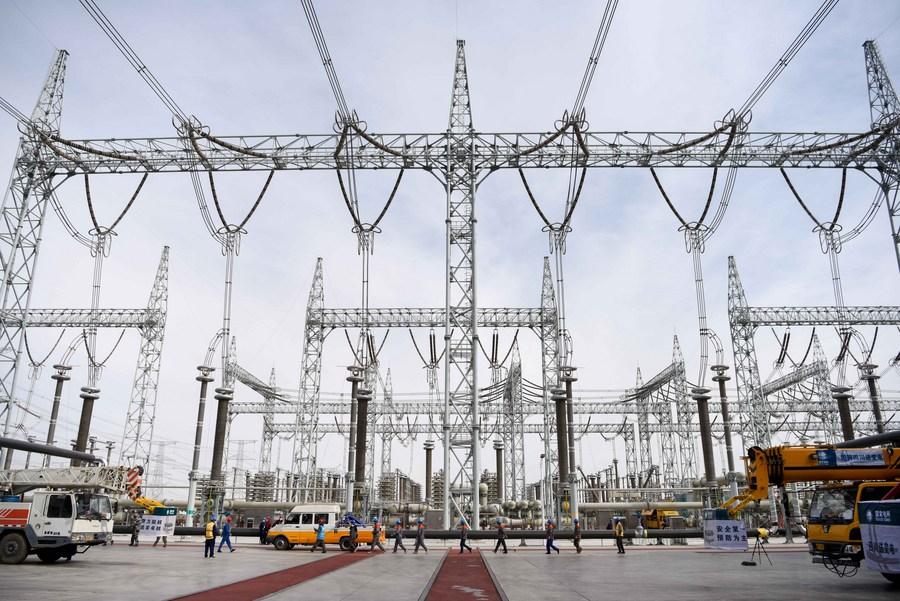BEIJING, Dec. 29 (Xinhua) -- The Chinese economy has quickly bounced back from the setback of an energy crunch that caught the world off guard amid the continuous fight against COVID-19 in 2021.
The tight supply and high demand for power, a dilemma besetting China's power industry since the start of this year, worsened in September and October due to the short supply and price hikes of coal. At the time, multiple provinces in the country reported power rationing with some regions experiencing power cuts.
The problem eased beginning in late October, however, with growing capacity for coal production having raised the supply, and power rationing phased out across the country. The National Energy Administration (NEA) said in a recent statement that the country's power use kept growing while the economy maintained a stable recovery.
In the first 11 months of this year, China's power consumption totaled 7.5 trillion kWh, up 11.4 percent from a year earlier and 15.1 percent from the same period in 2019, NEA data showed.
QUICK, WELL-ORCHESTRATED RESPONSE
To fill the power gap, government organs and industry businesses across China acted swiftly, taking a slew of measures to beef up production, reining in prices, facilitating transportation of coal and ensuring the household power supply as well as normal factory activities.
China's top economic planner, the National Development and Reform Commission, issued a circular to all localities and industry businesses in late September and called for the signing of mid- to long-term coal supply contracts among power generators and heating suppliers, in order to secure sufficient coal for the sector, especially for household use.
In the following days, key power producers and heating suppliers in northeast China, where power outages were most serious, clinched supply contracts, through which their coal demand for the coming winter was sufficiently covered.
Centrally administered state-owned enterprises, being important coal producers, were also mobilized by China's top state assets regulator to prioritize coal output and supply through measures including ramping up electricity coal production and scaling up imports.
The State Grid Corporation of China, the country's largest state-owned utility company, responded by strengthening the distribution of power across the entire network, coordinating electricity transmission to power-hungry provinces and regions, and keeping a close eye on power consumption.
Rail and shipping companies stepped in to fully tap their transport capacities and prioritize orders from power generators and heating suppliers. Data from the China State Railway Group Co., Ltd. showed that the volume of coal transported by trains and ships in China surged in October and November.
These timely measures, at both the local and central levels, proved effective in restoring near-term coal supply and helped gradually ease the strain on power generation, industry insiders noted.
Spot prices and coal futures have slumped rapidly since mid-October as long-term supply contracts cover more coal producers while supervision is strengthened to rein in excessive speculation. By early November, power supply and demand in areas operated by the State Grid had returned to normal.
Despite the disruption from power shortages, the Chinese economy registered growth of 9.8 percent in the first three quarters and is on a solid path to achieve the year's growth target.
NON-STOP EFFORTS
With notable progress achieved in the battle to alleviate energy shortages, the country is sparing no efforts to promote the long-term growth of the energy sector. Relevant governmental departments held a flurry of meetings, consulted with industry professionals and introduced a series of policy documents.
In late October, an official document was released saying that by 2060, China will have fully established a clean, low-carbon, safe and efficient energy system, with energy efficiency reaching the advanced international level.
At the annual Central Economic Work Conference held earlier this month, Chinese leaders reviewed the year's economic work and made arrangements for next year, stressing the need to strengthen the clean and efficient use of coal and phase out traditional energy based on safe, reliable new energy alternatives.
The country will also continue to increase the absorptive capacity of new energy, and optimize the use of coal and new energy. Large firms, especially state-owned enterprises, are working on the front lines of securing the power supply and stabilizing prices.
Acknowledging the role of coal as the country's dominant energy source for the near future, some experts have pitched methods of improving the efficiency of the use of coal by exploiting and utilizing coal in a cleaner way with advanced technology.
China is the largest coal producer and consumer of coal in the world. Thermal power still takes up a large share of China's energy output, accounting for about 70 percent of the country's power generation.
The country's coal chemical industry has already overcome formidable technical problems including coal gasification and liquefaction with a range of key technical equipment taking the lead globally, researchers noted.
"A new type of power system fuelled mainly by new energy must be built," Zhang Xiaoqiang, executive deputy head of the China Center for International Economic Exchanges said, adding that the country must actively develop new energy and beef up energy storage, as well as speed up the construction of a power supply featuring flexible adjustment.
In the January-November period, China's total installed power generation capacity expanded by 9 percent year on year to 2.32 billion kilowatts, with wind power capacity soaring 29 percent to 300 million kilowatts and solar power capacity surging 24.1 percent to reach 290 million kilowatts, NEA data showed.
Meteorological services are also expected to play a role in serving the energy safety in China, with forecasting and early warning of weather disasters further strengthening and weather services for the production, distribution and transportation of coal, electricity, oil and gas further built up, said a five-year plan on meteorological services in 2021-2025. Enditem




 A single purchase
A single purchase









